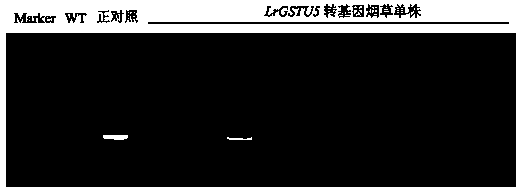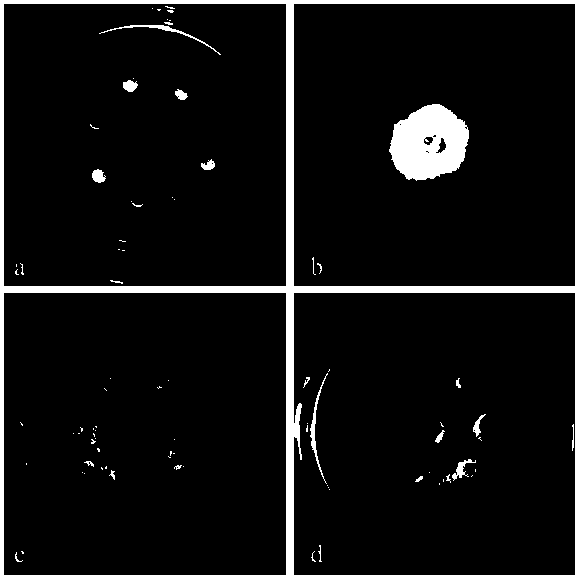Lilium regale glutathione S-transferase gene LrGSTU5 and application thereof
A technology of lily glutathione and glutathione, which is applied in the field of molecular biology and genetic engineering, can solve the problems that cannot fundamentally solve the problems of plant diseases, adverse effects on human and animal health and ecological balance, and few beneficial variations. Achieve broad market application prospects, reduce the use of pesticides, and shorten the breeding cycle
- Summary
- Abstract
- Description
- Claims
- Application Information
AI Technical Summary
Problems solved by technology
Method used
Image
Examples
Embodiment 1
[0023] Example 1: LrGSTU5 Cloning and sequence analysis of full-length genes
[0024] Inoculate Minjiang Lily with Fusarium oxysporum, extract total RNA from the root 24 hours after inoculation, grind the treated root of Minjiang Lily into powder with liquid nitrogen, transfer it to a centrifuge tube, and extract with guanidine isothiocyanate method For total RNA, use reverse transcriptase M-MLV (promega) to synthesize the first strand of cDNA using total RNA as a template. The reaction system and operation process are as follows: take 5 μg Total RNA, add 50 ng oligo(dT) 15, DEPC water to The reaction volume is 12.5 μL; after mixing, heat and denature at 70°C for 5 minutes, then quickly cool on ice for 5 minutes, then add 4 μL 5×First-stand buffer, 0.5 μL RNasin (200U), 2 μL dNTP (2.5mM each) , 1 μL M-MLV (200U), mix well and centrifuge for a short time, incubate at 42°C for 1.5h, take it out and heat at 70°C for 10min to terminate the reaction. After the first strand of cDN...
Embodiment 2
[0027] Embodiment 2: plant expression vector construction
[0028] Use the SanPrep column type plasmid DNA mini-extraction kit (Shanghai Sangong) to extract the insert LrGSTU5 Escherichia coli plasmid pMD-18T- LrGSTU5 As well as the plasmid of the plant expression vector pCAMBIA2300S, 1 μL was used for agarose gel electrophoresis to detect the integrity and concentration of the extracted plasmid. use Bam HI (TaKaRa) and Pst I (TaKaRa) for plasmid pMD-18T- LrGSTU5 and pCAMBIA2300S for double enzyme digestion (100 μL system), the reaction system and operation process are as follows: take 20 μL pMD-18T- LrGSTU5 or pCAMBIA2300S plasmid, add 10 μL 10×H buffer, 5 μL Bam HI, 5 μL Pst I. 60 μL ddH 2 O, after mixing, centrifuge for a short time, and place at 37°C for overnight reaction. Spot all digested products on agarose gel for electrophoresis, and then LrGSTU5The fragment and the pCAMBIA2300S large fragment were gel-recovered separately, and the SanPrep column DNA gel...
Embodiment 3
[0031] Example 3: Plant genetic transformation mediated by Agrobacterium and screening of transgenic plants
[0032] The transgenic recipient in this experiment is tobacco. Soak the tobacco seeds in 75% alcohol for 30s, wash them with sterile water and wash them with 0.1% HgCl 2 Disinfect the surface for 8 minutes, then wash several times with sterile water, sow on 1 / 2 MS medium, culture in dark at 28°C for 5-8 days, and transfer to light incubator after germination (25°C, 16h / d light) , and then subculture once a month with MS medium.
[0033] Take out the stored pCAMBIA2300S containing pCAMBIA2300S from the -80℃ refrigerator -LrGSTU5 The plasmid Agrobacterium LBA4404 strain was inoculated in 5 mL of LB liquid medium containing 50 mg / L Km and 20 mg / L rifampicin, and cultured at 28°C until cloudy. Pipette 1 mL of turbid bacterial solution onto LB solid medium containing 50 mg / L Km, incubate at 28°C for 48 hours, scrape off the Agrobacterium on LB solid medium and inoculate ...
PUM
| Property | Measurement | Unit |
|---|---|---|
| molecular weight | aaaaa | aaaaa |
Abstract
Description
Claims
Application Information
 Login to View More
Login to View More - R&D Engineer
- R&D Manager
- IP Professional
- Industry Leading Data Capabilities
- Powerful AI technology
- Patent DNA Extraction
Browse by: Latest US Patents, China's latest patents, Technical Efficacy Thesaurus, Application Domain, Technology Topic, Popular Technical Reports.
© 2024 PatSnap. All rights reserved.Legal|Privacy policy|Modern Slavery Act Transparency Statement|Sitemap|About US| Contact US: help@patsnap.com










